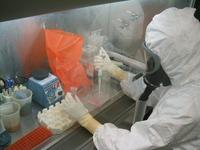-
New U.S. biodedfense R&D network launched
On Monday, Texas A&M System dedicated a new research center which is part of a national network of centers aiming to develop strategies and products to counter bioterrorism, chemical and radiological attacks on the United States, and better strategies to deal with pandemics; the network will have facilities in Texas, Maryland, and North Carolina; the Texas dedication is the culmination of a Manhattan Project-like program for biological countermeasures, launched in 2004 by the Department of Health and Human Services; the research network aims to develop “rapid, nimble and flexible approaches” to vaccine and therapy development, and train the next generation of professionals to sustain U.S. capabilities in these areas
-
-
New rapid diagnostic test for pathogens, contaminants developed
Using nanoscale materials, researchers have developed a single-step method rapidly and accurately to detect viruses, bacteria, and chemical contaminants; the method could be used to detect pathogens and contaminants in biological mixtures such as food, blood, saliva, and urine
-
-
Scaled-back Kansas biolab would meet U.S. needs

A report by the National Research Council says that it is “imperative” that the United States build a large-animal biocontainment laboratory to protect animal and public health; two options are acceptable: a $1.4 billion Biosafety Level 4 laboratory in Manhattan, Kansas, or a scaled-back Kansas lab tied to a distributed laboratory network in other facilities; a third option will not meet U.S. needs: maintaining current capabilities at Plum Island Animal Disease Center, because the Plum Island facilities do not meet current standards for high biocontainment
-
-
Northrop Grumman's biodetection solution completes field test
Northrop Grumman says its Next Generation Automated Detection System (NG-ADS) for homeland defense applications has successfully completed a field test and is ready for the program’s next phase
-
-
The true cost of cybercrime
The first systematic study of the cost of cybercrime recommends that society should spend less on antivirus software and more on policing the Internet
-
-
Researchers achieve world record cryptanalysis of next-generation cryptography
Researchers broke a world cryptography record with the successful cryptanalysis of a 278-digit (923-bit)-long pairing-based cryptography, which is becoming the next generation cryptography standard
-
-
Novel antitoxin strategy may target other pathogens
A low-cost, easy-to-replicate tool – based on a “beads on a string” approach — has demonstrated applications against several different toxins, from those found in contaminated food to those used in bioterrorism, and may also prove effective in targeting other types of pathogens
-
-
Report: Updated DHS risk assessment of Kansas lab still “technically inadequate”
Congress was unsatisfied with a 2010 DHS risk-assessment study of the proposed National Bio- and Agro-Defense Facility (NBAF) in Manhattan, Kansas, and asked for a new study of the risks, and an evaluation of the new study by the National Research Council; the evaluation says that some of the risk reduction noted in the new DHS risk assessment may be explained by improvements to the latest design plans for the facility, but that despite these improvements, the updated DHS assessment underestimates the risk of an accidental pathogen release and inadequately characterizes the uncertainties in those risks
-
-
“Killer silk” kills anthrax and other microbes in minutes
A simple, inexpensive dip-and-dry treatment can convert ordinary silk into a fabric that kills disease-causing bacteria — even the armor-coated spores of microbes like anthrax — in minutes
-
-
Congress considering biodefense measure

H.R. 2356, the WMD Prevention and Preparedness Act of 2011, will soon be debated before four different House committees, before going to the Senate to be debated further – all this four years after a congressionally mandated commission defined bioterrorism as a grave threat to the United States; critics charge that the reason is the unwieldy and dysfunctional manner in which Congress oversees DHS: currently there are 108 congressional committees and subcommittees with oversight responsibilities for different parts of DHS
-
-
Al-Awlaki, posthumously, urges biological, chemical attacks on U.S.

In a 5-page article published in al Qaeda in Yemen’s English-language magazine, Anwar al-Awlaki, the U.S.-born jihadist who was killed last September by a missile launched from a CIA-operated drone, writes that the use of poisons of chemical and biological weapons against U.S. population centers is allowed and strongly recommended “due to the effect on the enemy”
-
-
Insider: H5N1 studies publication vote biased, unbalanced
In late March, the National Science Advisory Board for Biosecurity (NSABB) reversed its earlier recommendation, made in December 2011, against full publication of two studies describing lab-modified H5N1 viruses with increased transmissibility in mammals; the recommendation was based on fears that the findings would help terrorist design effective bioweapons; a NSABB board member says that the March reversal of the December recommendation was the result of a bias toward finding a solution that was more about getting the government out of the current dilemma than about a careful risk-benefit analysis
-
-
FDA considers placing anthrax kits in American households
The FDA is examining distributing anthrax med kits to 114 million American households; the agency is concerned about the possible misuse of the kits, and about whether their distribution would lead people to believe an anthrax attack was imminent, causing panic
-
-
Inovio Pharmaceuticals gets DoD continuation grant for synthetic DNA vaccine delivery device
The U.S. Department of Defense has given a Small Business Innovation Research grant to Inovio Pharmaceuticals to continue developing a low-cost, non-invasive surface electroporation (EP) delivery device; the testing of the device in conjunction with Inovio’s synthetic DNA vaccines against viruses with bioterrorism potential, including hanta, puumala, arenavirus and pandemic influenza
-
-
Army scientists work to improve biothreat detection
A married couple, both scientists working at the U.S. Army’s Edgewood Chemical Biological Center, one of forty-five Biosafety Level 3 labs in the United States; they collaborate on improving the ability of soldiers and first responders to detect, identify, and protect against potentially lethal biological threat agents
-
- All
- Regional
- Water
- Biometrics
- Borders/Immig
- Business
- Cybersecurity
- Detection
- Disasters
- Government
- Infrastructure
- International
- Public health
- Public Safety
- Communication interoperabillity
- Emergency services
- Emergency medical services
- Fire
- First response
- IEDs
- Law Enforcement
- Law Enforcement Technology
- Military technology
- Nonlethal weapons
- Nuclear weapons
- Personal protection equipment
- Police
- Notification /alert systems
- Situational awareness
- Weapons systems
- Sci-Tech
- Sector Reports
- Surveillance
- Transportation
Advertising & Marketing: advertise@newswirepubs.com
Editorial: editor@newswirepubs.com
General: info@newswirepubs.com
2010-2011 © News Wire Publications, LLC News Wire Publications, LLC
220 Old Country Road | Suite 200 | Mineola | New York | 11501
Permissions and Policies
Editorial: editor@newswirepubs.com
General: info@newswirepubs.com
2010-2011 © News Wire Publications, LLC News Wire Publications, LLC
220 Old Country Road | Suite 200 | Mineola | New York | 11501
Permissions and Policies
